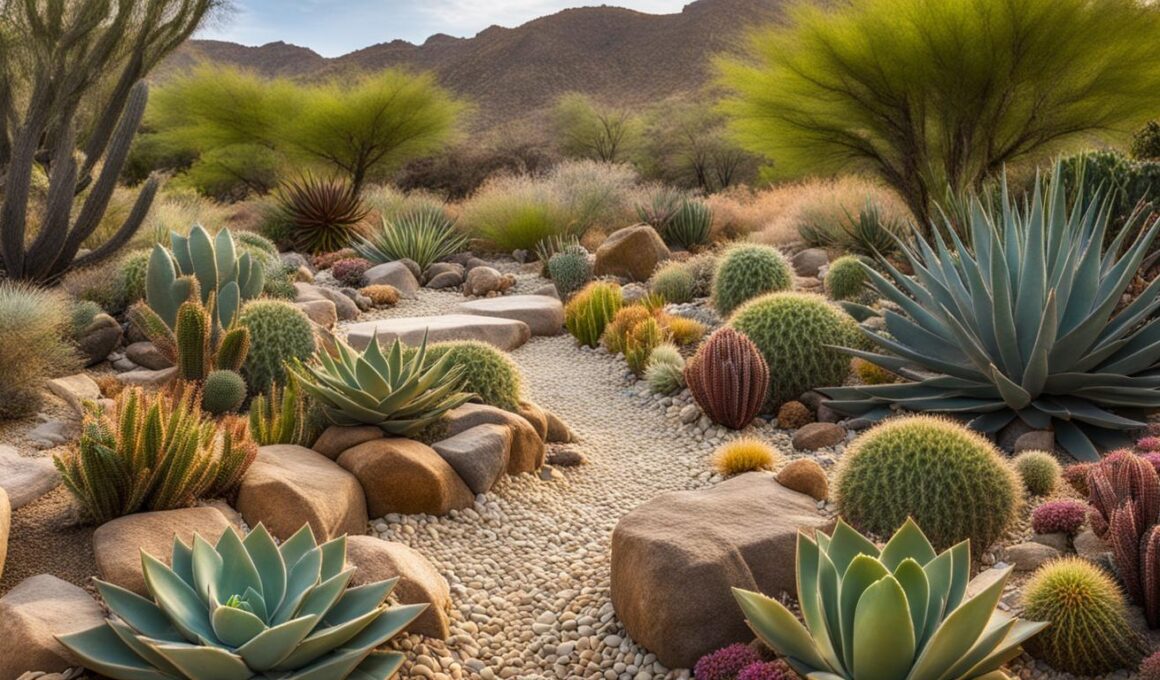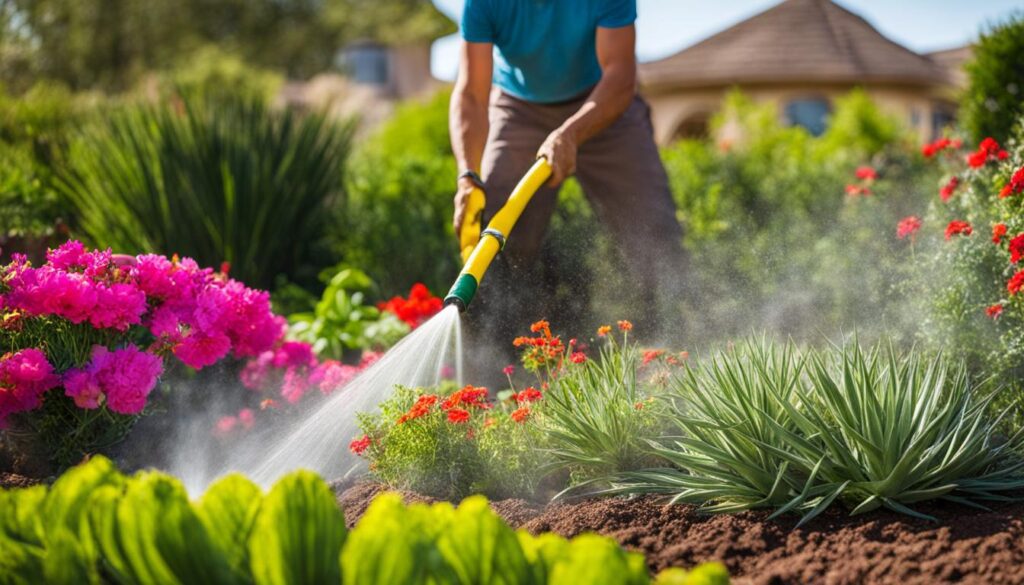Xeriscaping is an effective landscape design that allows homeowners to have a beautiful and thriving landscape while conserving water. It involves using drought-tolerant plants and materials that require little or no water beyond what occurs naturally. The concept of xeriscaping was coined in the 1980s by the Denver, Colorado water department to encourage water conservation in dry climates. Xeriscaping offers numerous benefits, including water and cost savings, time efficiency, and environmental protection. Implementing a xeriscape design involves careful planning, testing the soil, reducing or eliminating turfgrass, choosing the right plants, spreading mulch, irrigating properly, and maintaining the xeriscape appropriately.
Key Takeaways:
- Drought-tolerant xeriscape is an effective way to conserve water in landscaping.
- Xeriscaping offers various benefits, including cost savings and environmental protection.
- Implementing a successful xeriscape design requires careful planning and choosing the right plants.
- Proper irrigation techniques and mulching help in water conservation and maintaining a thriving xeriscape.
- Xeriscaping contributes to creating a beautiful, sustainable landscape and conserving water resources.
Planning Your Xeriscape Design
When it comes to planning your xeriscape design, it’s essential to take into consideration the unique characteristics of your yard. Understanding factors such as sun exposure, drainage, slopes, and soil type is crucial for creating a successful and water-efficient landscape. By gathering this information, you can determine the watering needs of different areas and create hydrozones where plants with similar requirements are grouped together.
In order to maximize water usage and promote healthy plant growth, it’s recommended to designate the largest area of your yard for drought-resistant plants. These plants have the ability to thrive with minimal water, making them ideal for xeriscaping. Additionally, consider placing zones that require more water closer to your house, ensuring that they receive the attention they need while minimizing water waste.
Proper planning is key to achieving an efficient xeriscape design. By considering your yard’s specific characteristics and grouping plants based on their watering needs, you can create a visually stunning landscape that conserves water and supports the growth of thriving plants.
Choosing the Right Plants for Xeriscaping
Selecting the right plants is crucial for a successful xeriscape design. When it comes to drought-tolerant plants, native species are your best choice. These plants have adapted to the local climate and require less water to thrive. By incorporating native plants into your xeriscape, you can minimize water usage and create a sustainable landscape.
Consider the water requirements of each plant before selecting them for your xeriscape. Some plants, like succulents, have low water needs, while others may require moderate watering. By grouping plants with similar water requirements together, you can ensure efficient irrigation and prevent overwatering. This also allows you to tailor the watering schedule to each group, conserving water and promoting plant health.
When choosing plants for your xeriscape, it’s important to provide adequate spacing for their growth. This ensures that the plants have enough room to flourish without competing for resources. Additionally, proper spacing allows for easy maintenance and avoids interference with utilities or power lines. By following these guidelines, you can create a visually appealing and functional xeriscape that thrives with minimal water.
How Can Sustainable Irrigation Solutions Help Maintain a Drought-Tolerant Xeriscape?
Sustainable xeriscape irrigation solutions play a crucial role in maintaining a drought-tolerant xeriscape. By utilizing efficient watering techniques and incorporating water-saving technologies, sustainable irrigation systems help conserve resources and support the growth of low-maintenance, water-wise landscaping. This approach ensures the longevity and resilience of xeriscapes in arid climates.
Implementing Irrigation and Mulching Techniques
Proper irrigation techniques play a vital role in xeriscape maintenance. To conserve water and promote efficient watering, consider installing soaker hoses or a drip irrigation system. These systems deliver water directly to the root zone of drought-tolerant plants, minimizing water waste. Soaker hoses are porous and release water slowly, allowing it to seep into the soil without runoff. Drip irrigation systems use emitters to deliver water directly to the base of each plant, ensuring targeted hydration.
For turfgrass areas in your xeriscape, it’s essential to adopt proper watering practices. Water deeply and infrequently, preferably early in the morning, to promote deep root growth. This helps the grass become more resilient and reduces its water requirements. A general rule of thumb is to provide one inch of water per week, including rainfall. Using a rain gauge or soil moisture meter can help you monitor moisture levels and adjust watering schedules accordingly.
In addition to efficient irrigation, mulching is an excellent technique for water conservation and overall xeriscape maintenance. Applying a layer of mulch around your plants helps retain moisture, suppress weed growth, and regulate soil temperature. Straw, pine bark, or rocks can serve as effective mulch materials. Be sure to spread the mulch around the base of each plant, avoiding direct contact to prevent damage or rot. Mulch also adds organic matter to the soil as it breaks down, providing nutrients to your plants.
Irrigation and Mulching Tips:
- Install soaker hoses or a drip irrigation system to minimize water waste and deliver water directly to the root zone.
- Water turfgrass deeply and infrequently in the early morning to promote deep root growth.
- Use a rain gauge or soil moisture meter to monitor moisture levels and adjust watering schedules accordingly.
- Apply a layer of mulch around plants to retain moisture, suppress weed growth, and regulate soil temperature.
- Choose mulch materials like straw, pine bark, or rocks and spread them around the base of each plant.
What Maintenance Tips Should I Follow for Xeriscaping in Drought-Prone Areas?
When it comes to xeriscaping for drought areas, there are a few maintenance tips to keep in mind. First, choose drought-resistant plants and use mulch to retain moisture. Second, regularly check and adjust your irrigation system to ensure efficient water use. Lastly, remove weeds to reduce competition for water.
Conclusion
Xeriscaping offers numerous benefits that go beyond just conserving water. By embracing this sustainable landscape design, you can not only create a beautiful outdoor space but also contribute to water conservation efforts and reduce maintenance requirements.
One of the key advantages of xeriscaping is its efficiency in water usage. With the right planning, choosing drought-tolerant plants, and implementing proper irrigation techniques, you can significantly reduce water consumption while still maintaining a thriving landscape.
Furthermore, xeriscaping saves you both time and money. With minimal watering needs and reduced maintenance requirements, you can spend more time enjoying your outdoor oasis, rather than constantly tending to it. Additionally, xeriscaping can lower water bills and minimize the need for expensive lawn care products.
Ultimately, by embracing xeriscaping, you are making a positive impact on the environment. Water conservation is crucial, especially in regions prone to drought and water scarcity. By implementing xeriscape principles, you are taking a proactive step towards a greener future.










